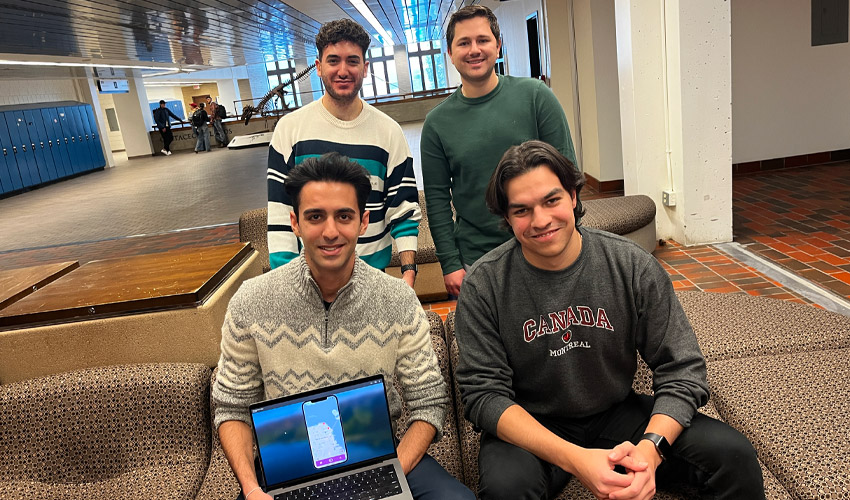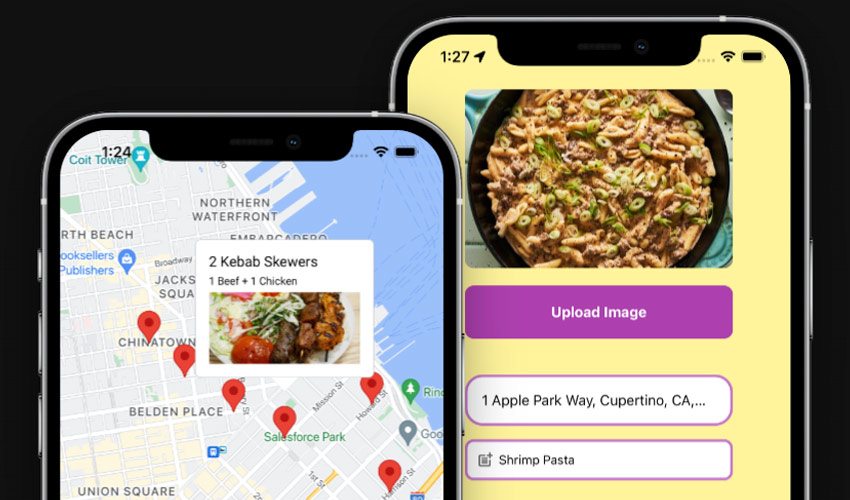Social solutions through software engineering
BCIS students use assignment to tackle food insecurity issues
— Mount Royal University | Posted: December 13, 2022

(Back row left to right) Christian Shammas and Brandon Bodemer (front row left to right) Ramin Radmand and Diego Anzola used a Bachelor of Computer Information Systems assignment to try to address food insecurity.
A Bachelor of Computer Information Systems (BCIS) assignment started as the relatively straightforward task of creating a software application, but ended up turning into a lesson on food insecurity, food safety and the food waste industry for four students.
The mission was to create an app for Assistant Professor Yasaman Amannejad, PhD’s, COMP 3504 course, which covers software engineering concepts.
“Throughout this course students work on a project of their choice, from identifying what they want to work on, to gathering requirements for their application, to (ultimately) building the application,” Amannejad says.
Diego Anzola, Brandon Bodemer, Ramin Radmand and Christian Shammas came up with the idea for a social enterprise app connecting those in need of food with those who have it.
A recent survey carried out by MRU faculty members revealed that 9.52 per cent of all MRU students suffer from food insecurity, with 75 percent of those who responded saying that they are severely food insecure (skipping meals, unable to purchase food, sleeping to avoid eating, etc.). The study is one of the largest ever conducted in Canada and highlights the critical importance of food security projects, such as the Care Cupboards installed by the Students’ Association of Mount Royal University this past semester.
“When this project came up in our class, we were trying to think of what topic would not only fulfill the requirements of making an app, but also be something good that we are proud of and that people can actually end up using once the project is done,” Anzola explains.
How the app, which is named WeGiveYouEat, can work would be a situation such as a party where 20 pizzas are ordered, but only 15 are eaten. Someone could then post the extra pizzas on the app with the location, an image, a title and a description. Users can then come and pick up the extra pizzas or work out another method to retrieve them.

The WeGiveYouEat app is an attempt to connect those who have excess food with those who can use it.
“We know that people are having issues with food insecurity, and it is sad to see food go to waste,” Bodemer says.
A lesson learned through the process of the building and critique of WeGiveYouEat was that there are strict guidelines and regulations around donating food and food safety.
“Unfortunately, you can’t just go and offer food,” Radmand says. Risks involve people picking up food that has gone bad, or even someone posting food for pickup that has been contaminated on purpose. In Alberta, food donors are somewhat protected under the Charitable Donation of Food Act, however they are open to liability if it can be proven that the food was unfit for human consumption or was intended to harm or injure the recipient.
The group is carefully looking into properly donating food before proceeding, and may potentially draft a user agreement to help address legal issues. They have the hope they can eventually run their app as a non-profit business.
The build and what it revealed
Anzola Mendez, Bodemer, Radmand and Shammas began their project thinking they would just build an Android app, but after some research they realized they wanted WeGiveYouEat to be accessible to as many people as possible.They switched to different software to include both iOS and Android users and accessed Google Cloud services to keep everything in one location, Radmand explains.
They also realized they would need to have a level of moderation, in case someone starts posting items they simply don’t want.
Amannejad is impressed by the work and dedication shown by the team.
“From a technical perspective, what they have achieved within the timeline they had was very impressive. They have learned and used new programming languages and new cloud technologies for their application. The fact that they also chose to work on a project with a good social cause was impressive,” Amannejad says.
All four say they appreciate how their BCIS education has allowed them to create solutions to real-world problems in real time.
“With the BCIS classes you have a very unique and creative approach to every assignment, such as how you want to write it, choosing the languages and technologies, figuring out what kind of website you want to make and how you want to add your own personal touch. I feel like the freedom to learn new things on your own or explore topics in your own way makes it really interesting,” Shammas says.
The group credits Amannejad for her support throughout the project, saying she was always available, supportive and willing to assist.
“Students in our computer science and BCIS programs learn a wide range of skills to work and also learn to build different technologies. The impact of technology in our society and also in our daily lives is inevitable,” Amannejad says.

